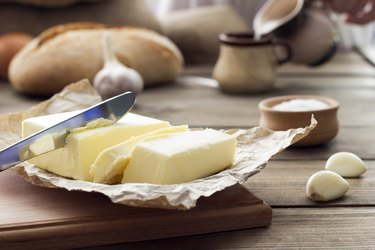
Novice bakers are often intimidated by the idea of substituting a major ingredient, such as butter, in their baked goods. Baking holds a reputation as a stern taskmaster, demanding precision and punishing any deviation from the recipe. There is a kernel of truth in this. You can't blindly make changes to a recipe's chemistry and expect it to work, but -- and this is important -- you can make informed changes. So, if your recipe calls for butter and all you have is shortening, you just need to know how they differ.
Measuring Apples and Oranges
Video of the Day
A stick of butter measures 1/2 cup, so a half-cup of shortening might appear to be its direct replacement. That's not true in real-life baking, because shortening is a pure fat and butter is not. Most butter is roughly 80 percent fat, with water accounting for most of the remainder.
Video of the Day
If your recipe calls for just one stick of butter you can usually get away using a shortening substitute, but you'll see differences in the texture of the finished baked good. For example, cookies that spread and develop crisp edges when made with butter will be puffy and cake-like when made with shortening. It's not quite an apples-to-oranges difference, but some adjustments will definitely give you a better result.
Tweaking the Recipe
Adjusting a commercial-sized recipe requires careful calculation, but you don't need to be that precise in a home recipe. A stick of butter equals 8 tablespoons or 1/2-cup, of which something close to 1 tablespoon is water. To replace a stick of butter with shortening, remove one tablespoon of shortening from your half-cup and replace it with water or milk. This restores the fat and liquid to approximately their original proportions, and should result in perfectly acceptable quick breads or cakes.
Adjusting for the Temperature Issue
Cookies are more problematic. Even after adding liquid, you still might find that your cookies bake up puffy and cake-like rather than flat and crisp. That's because shortening melts at a higher temperature than butter, so the cookies begin to "set" before the dough softens and spreads.
Tip
You can counter this by flattening the cookies by hand, rather than simply dropping balls onto the sheet, or by resting each sheet for a few minutes on the warm-from-baking stovetop before it goes into the oven. Cookies made with shortening will usually be paler than butter cookies, as well.
Differences Between Butter and Shortening
Shortening is a superior baking fat in many respects. Any cake or quickbread that calls for its fat to be creamed with sugar will be lighter and more appealing when it's made with shortening. Shortening stays stiffer at room temperature than butter does, so it traps more air and leavens the goods more effectively. It also contains emulsifiers that help the shortening mix better with the flour, sugar and other ingredients.
The Flavor Comparison
The major shortcoming using shortening over butter is its lack of flavor. Butter has a distinctively rich taste, and many recipes -- such as shortbread cookies -- rely on it almost entirely for their flavor. Shortening-based baked goods lack that. Also, cookies and frostings made with shortening can leave your mouth feeling greasy. That's because butter melts at body temperature and shortening doesn't; so the treats leave a film of shortening in your mouth. Some bakers compromise by mixing butter and shortening in the recipe, gaining the creaming prowess of the shortening but keeping the butter's rich flavor.